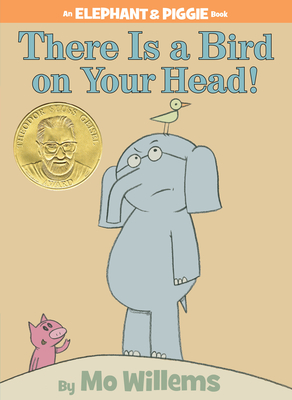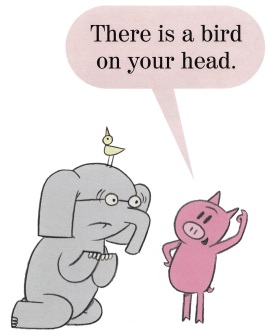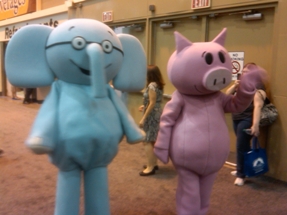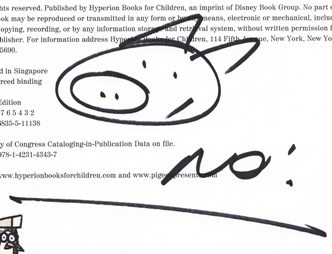The 16th Elephant and Piggie book by Mo Willems, Happy Pig Day!, is being released today and, in honor of its publication, I spent last night composing this long-winded ode to the Elephant and Piggie series, a collection of easy reader titles that have had a big impact on our household. I’ve wanted to write about Elephant and Piggie for a while now, but it’s hard to know where to begin. Because, at this point, the way I feel about Mo Willems as a children’s book creator is the same way I feel about the Coen Brothers as film directors. It’s not a question of which of their works are good and which are bad. It’s pretty much just a question of measuring excellence.
Quick semi-related diversion: In my opinion, the Coen Brothers have never made a bad movie – yes, Ladykillers wasn’t Raising Arizona, but it was way better than most average film comedies (for Hanks’ lead performance alone), and Intolerable Cruelty is an unheralded gem – so, when discussing their films, I mostly just find myself ranking favorites. The same thing happens when I talk about Mo Willems. I simply have yet to meet a Willems title that my family hasn’t enjoyed. So, when looking at his whole body of work, I’ll admit, it turns into a semi-pointless exercise of pure fanboy-esque categorization, with me ranking his titles from “the very best” to the “normal best.” (Ooh, aren’t I a harsh headmaster? Grading his books from “A+” all the way to “A-“.)
That being said, although I love the Pigeon (like many others, Don’t Let the Pigeon Drive the Bus was our first Willems title), the large bulk of my Mo-love is reserved for the Elephant and Piggie books, a remarkable series for beginning readers. The E&P series, which began in 2007 with There Is a Bird on Your Head!, falls under the category of “easy readers”, a term that generally describes books designed for children who are just starting to read on their own. Easy readers are equal parts illustrations and large, easy-to-read text, and their vocabulary is normally limited to words that appeal to kindergarten to second-grade reading levels.
The Elephant and Piggie books boil down the easy reader to its essential components. The lead characters, Gerald the elephant and Piggie the pig, stand in front of a plain white backdrop, acting out their stories with just their body language and bare minimum of props. The earnest duo – like a more affectionate animal version of Laurel and Hardy – communicate through sound effects and large-text word balloons that make it easy for kids to pick out key words and follow the action. The dialogue-driven E&P books are, actually, a lot like wonderful, condensed one-act plays for kids. There are series of engaging verbal volleys between Elephant and Piggie in each volume, replete with knowing humor, repetition, and facial expressions that really help the young readers understand the inflection and emphasis of the words.
That’s a very obtuse way of saying the books are really, really funny, and Elephant and Piggie come across like such charismatic, three-dimensional characters that they quickly feel like old friends. And, while there are some easy readers that feel like they’re maybe a little too advanced for truly beginning readers, the E&P books are simple enough that newer readers will embrace them, but sophisticated enough that children from first grade-up will still enjoy reading them.
And, despite their deceptively simple appearance, you’d be amazed at the sheer level of work that goes into creating books that are this direct, accessible, and entertaining. There was a very cool article in the June 2011 issue of Book Links – titled “New Friends for New Readers” – in which the article’s author, Robin Smith – discusses the development of the E&P series with Mo Willems. (You can access the whole article here, but you need a subscription.) And I was completely blown away by the amount of effort that Willems puts into each volume. In his own words:
“Easy Readers” are also known as “Hard Writers,” which is part of the fun. My primary goal is to create real stories that are as funny and exciting as possible – stories that don’t feel like early readers. After having written what I hope is a good story, I check my dialogue against a list of words organized by their grade levels, attempting to keep every word at a first-grade level or below (although I’ll let a second-grade word slip through if I feel it can be discerned in the context of the story). The subsequent draft of each book is then vetted by an actual, living language specialist and, where possible, an actual, living early reader.
How impressive is that? That level of craftsmanship makes me excited to hand these books over to my daughter.
But if you really want to know why the Elephant and Piggie books are exceptional examples of the easy reader format, I dare you to go out to any local big-box bookstore and try to find some really compelling easy readers – books that don’t just deliver vocab words, but tell a real story too. Since I’ve been in your shoes before, let me tell you what you’ll find. You’ll spend a great deal of time simply searching for the limited number of easy readers in the children’s section, which will either be displayed on a spinning rack, showing off 8 or so titles max, or they’ll be shoved together on a shelf, which, since the volumes are so thin, makes it almost impossible to read the spines and see what titles are available. Once you do find the easy readers (probably on the spinning rack), 95% of them will be crappy movie or TV-show tie-ins. You’ll see tons of I-Can-Read options featuring Cars 2, Kung-Fu Panda, Batman, Ben 10, Barbie, or Star Wars, among other corporate entities, and, if you’re lucky, you MIGHT a title or two from the other 5% – usually, it’ll be a Frog and Toad, Little Bear, or Fly Guy book. And, don’t get me wrong, those 5% series are all really well done, but the fact that you’ll find maybe 3 or 4 of them mixed in with a metric ton of I-Can-Read Green Lantern and Lego titles is more than a little depressing.
To be fair, that whole frustrating experience has a lot more to do with what chain bookstores stock in their kids’ section than what’s available in the entirety of children’s lit. But, more than any, ANY other children’s book format, I have the absolute hardest time finding easy readers that are worth a damn, which is why I have such a man-crush on Elephant and Piggie books. Not only are they awesome, but they’re also pretty easy to find. (And if you stack them on a shelf, you can actually read the spines too.)
But what’s the REAL reason why I love them so much? The Elephant and Piggie book, I Am Invited to a Party!, is one of the very first books that my 4-year-old daughter read all on her own. No memorization, it had never been read to her before – she picked it up and made her way through the whole book on her own, which was freaking amazing to watch. I’m still not sure what the best part of the experience was: my tidal wave of fatherly pride or the palpable sense of empowerment that swept over my daughter’s face as she finished the book and quickly realized what she had done.
I’ve had the chance to meet Mo Willems twice in person and, the last time, I was standing in line for an autograph, eagerly waiting to tell Mo how I Am Invited to a Party! was such a landmark book for my daughter. When I was finally one person away from the front of the line, the woman ahead of me walked up to Mo and told him ALMOST VERBATIM the exact thing I was going to say. She went on and on about how an Elephant and Piggie book – I think it was We Are in a Book! – was the first book her daughter read herself. She described the pride, the empowerment, the… OK, she said everything I was going to say. Truth be told, at the time, I was a little pissed off. That was MY story and, after I finally shook Mo’s hand, I sputtered something like “Yeah, that was weird… um, that lady had my exact same experience…” Mo was polite and thanked me for my mangled anecdote, but it really made me think about how powerful easy readers can be, IF they’re done right. And I have yet to encounter better easy readers than Elephant and Piggie. Sit back, watch your kids read them, and enjoy.
[Note: There are currently 16 Elephant and Piggie books. We own 7 of them – There Is a Bird on Your Head, Elephants Cannot Dance, I am Invited to a Party!, I Broke My Trunk, I Love My New Toy, Pigs Make Me Sneeze, and Should I Share My Ice Cream? We’ve also taken We Are in a Book!, possibly the funniest (and most meta) E&P book out from the library, at least, four times.]
THE DETAILS ON THE ELEPHANT AND PIGGIE SERIES:
AGE RANGE: Preschool to second grade, but they are fun books to read to pre-readers too.
PAGE COUNT: 64 pages
AUTHOR WEB SITE: Here’s the official Mo website with a ton of links to games, teacher resources, Mo’s blog, and The Pigeon’s own Twitter account.
BUY IT, BORROW IT, OR FORGET IT?: Buy them and horde them like canned food and shotguns on the eve of a zombie apocalypse. OK, that might be overstating a bit, but, truthfully, you won’t find higher quality material for beginning readers anywhere else.
IF YOU LIKED THE ELEPHANT AND PIGGIE SERIES, YOU MIGHT ALSO LIKE:
- Bink & Gollie by Kate DiCamillo and Alison McGhee, illustrated by Tony Fucile – The vocabulary of Bink & Gollie skews a bit older than the Elephant and Piggie books, but it has a similar spirit, tone, and format. Like E&P, Bink & Gollie revolves around a warm-hearted, fully fleshed-out friendship between two idiosyncratic pals – in this case, the older Gollie and her scruffy younger pal, Bink. (The difference in their relative sizes and the white backgrounds even somewhat mirror the look of Elephant and Piggie.) Through three short episodes, the girlfriends display their various quibbles and quirks, always realizing, in the end, how great it is to have a best friend. Tony Fucile’s art, in particular, makes this a standout title. Fucile’s only other children’s book, Let’s Do Nothing!, would also be a pretty solid Elephant and Piggie readalike.
- Duck! Rabbit! by Amy Krouse Rosenthal, illustrated by Tom Lichtenheld – Again, this title is more first/second-grade than kindergarten, but it definitely has the same sense of wild fun with storytelling that Willems evokes with the Elephant and Piggie books. In this ode to optical illusions, the reader is asked to debate whether the illustration that he or she is looking at is really a duck or a rabbit. It could be both, it could be neither. But the ongoing debate between the off-page characters will remind readers of the similar kinds of excitedly fun exchanges that Elephant and Piggie often indulge in.
- The Fly Guy Series by Tedd Arnold – In this series, a boy named Buzz adopts a household fly – whom he christens “Fly Guy” – as his pet. The duo embarks on a series of adventures from book to book, winning at a pet show, going on a family trip, introducing Fly Guy to a possible romantic interest, etc. Arnold’s cartoony illustrations are funny and compelling, and he really knows how to craft simple, readable stories for beginning readers. I remember reading Hi, Fly Guy, the first book in the series, with my daughter a year or two ago and noticing for the first time that she was beginning to pick out familiar words for herself, proudly slamming down her finger on the page and declaring, “Chapter One!”, “Buzz!”, and “Fly Guy!”




{ 0 comments… add one now }
You must log in to post a comment.